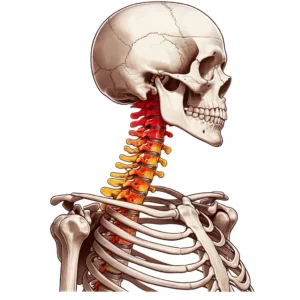What is a Cervical Spine Fracture?

A cervical spine fracture, commonly known as a broken neck, is a serious injury that can have life-altering implications. This type of fracture involves a break in one or more of the seven cervical vertebrae in the neck.
Understanding the nature of this injury, its symptoms, diagnosis, and treatment options is crucial for anyone who may be at risk or has experienced a traumatic event that could lead to such an injury.
Understanding Cervical Fractures
Cervical fractures typically result from high-impact incidents like car accidents, falls, or sports injuries. In some cases, conditions like osteoporosis, tumors, or infections can weaken the bones, making them more susceptible to fractures.
Symptoms of a Cervical Fracture
The most common symptom of a cervical fracture is neck pain, which may be accompanied by other signs:
- Difficulty moving or turning the head
- Swelling or bruising around the neck
- Numbness or tingling in the arms or legs
- Loss of bladder or bowel control in severe cases
In some instances, patients may not experience any noticeable symptoms, making it crucial to seek medical attention after any significant trauma to the neck.
Diagnosis and Evaluation
Diagnosing a cervical spine fracture involves a comprehensive assessment by medical professionals. This usually occurs in an emergency setting, where the neck is immobilized to prevent further injury. Diagnostic tools include:
- Radiographs (X-rays)
- CT scans for detailed imaging
- MRI scans, if nerve damage is suspected
The anatomy of the cervical spine is complex, consisting of seven vertebrae, intervertebral disks, and a network of ligaments. This structure is divided into three distinct columns: anterior, middle, and posterior. Damage to these areas can vary in severity and impact on spinal stability and neurological function.
The Evaluation Process
During the evaluation process, the spine is assessed for alignment, and any potential for spinal cord injury is determined. This evaluation is critical in cases where multiple columns are disrupted, increasing the likelihood of severe injury.

Treatment Options
The treatment for a cervical spine fracture depends on the nature and severity of the injury. Minor, non-displaced fractures may only require immobilization with a brace or neck collar. More severe cases, especially those involving spinal instability or nerve damage, may necessitate surgical intervention. Surgery aims to realign the spine, stabilize the affected area, and restore function.
The Risk of Cervical Spine Fractures
Certain demographics are more prone to cervical spine injuries. Statistics show that most cervical spine fractures occur at the C2 level and at the C6 or C7 levels. The risk is higher in individuals engaged in high-risk activities or those with pre-existing conditions that weaken the bone structure.
Pediatric Considerations
In children, the cervical spine is more flexible, making them more susceptible to neural damage before musculoskeletal injury. This heightened flexibility means that even minimal structural damage can have severe consequences in young patients.
Radiographic Evaluation
Radiographic evaluation plays a pivotal role in diagnosing cervical fractures. A standard trauma series may include several views (cross-table lateral, swimmer's, oblique, odontoid, and anteroposterior) to identify the injury. The advent of multidetector CT has enhanced the accuracy of these diagnoses, offering a more sensitive approach with lower rates of missed injuries.
Prognosis and Recovery
Recovery from a cervical spine fracture can be a lengthy process, often requiring physical therapy and rehabilitation. The prognosis depends on the extent of the injury and the effectiveness of the treatment. In some cases, full recovery is possible, while in others, there may be lasting neurological deficits or chronic pain.
Conclusion
Cervical spine fractures are severe injuries that require immediate medical attention. Understanding the symptoms, diagnostic processes, and treatment options is crucial for anyone at risk of such an injury. Prompt and appropriate medical care is vital to optimize outcomes and reduce the risk of long-term complications.
Dr. Abdul Baker - An Expert Neurosurgeon in Texas
Every neurosurgery has its complications; thus, a patient must choose the best neurosurgeon for himself. Dr. Abdul Baker is one of the most experienced and qualified neurosurgeons in Texas, treating patients for more than 16 years. People in Sherman, Plano, and nearby areas trust him for every kind of neurosurgery due to his surgical procedures’ 100% success rate. You may visit him if you need any consultancy or treatment regarding your brain and spine disorders.


Dr. Baker specializes in neurosurgery, neurosurgical spine surgery, neurotrauma, brain tumors, spinal tumors, and peripheral nerve damage treatment.









